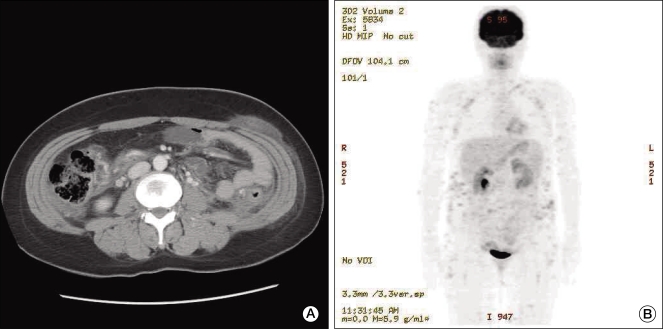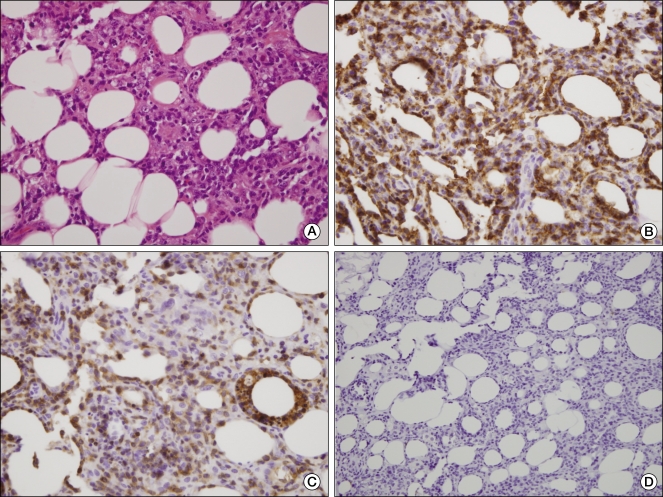1. Gonzalez CL, Medeiros LJ, Braziel RM, Jaffe ES. T-cell lymphoma involving subcutaneous tissue: a clinicopathologic entity commonly associated with hemophagocytic syndrome. Am J Surg Pathol. 1991; 15:17–27. PMID:
1985499.
2. Jaffe ES, Gaulard P, Ralfkiaer E, Cerroni L, Meijer CJ. Swerdlow SH, Campo E, Harris NL, Jaffe ES, Pileri SA, Stein H, editors. Subcutaneous panniculitis-like T-cell lymphoma. WHO classification of tumours of haematopoietic and lymphoid tissues. 2008. Lyon: IARC press;p. 294–295.
3. Go RS, Wester SM. Immunophenotypic and molecular features, clinical outcomes, treatments, and prognostic factors associated with subcutaneous panniculitis-like T-cell lymphoma: a systematic analysis of 156 patients reported in the literature. Cancer. 2004; 101:1404–1413. PMID:
15368328.
4. Willemze R, Jansen PM, Cerroni L, Berti E, Santucci M, Assaf C, et al. Subcutaneous panniculitis-like T-cell lymphoma: definition, classification, and prognostic factors: an EORTC Cutaneous Lymphoma Group Study of 83 cases. Blood. 2008; 111:838–845. PMID:
17934071.

5. Ghobrial IM, Weenig RH, Pittlekow MR, Qu G, Kurtin PJ, Ristow K, et al. Clinical outcome of patients with subcutaneous panniculitis-like T-cell lymphoma. Leuk Lymphoma. 2005; 46:703–708. PMID:
16019507.

6. Salhany KE, Macon WR, Choi JK, Elenitsas R, Lessin SR, Felgar RE, et al. Subcutaneous panniculitis-like T-cell lymphoma: clinicopathologic, immunophenotypic, and genotypic analysis of alpha/beta and gamma/delta subtypes. Am J Surg Pathol. 1998; 22:881–893. PMID:
9669350.
7. Zhang H, Gupta R, Wang JC, Lipton JF, Huang YW. Subcutaneous panniculitis-like T-cell lymphoma in a patient with long-term remission with standard chemotherapy. J Natl Med Assoc. 2007; 99:1190–1192. PMID:
17987923.
8. Reimer P, Rüdiger T, Müller J, Rose C, Wilhelm M, Weissinger F. Subcutaneous panniculitis-like T-cell lymphoma during pregnancy with successful autologous stem cell transplantation. Ann Hematol. 2003; 82:305–309. PMID:
12707721.

9. Mukai HY, Okoshi Y, Shimizu S, Katsura Y, Takei N, Hasegawa Y, et al. Successful treatment of a patient with subcutaneous panniculitis-like T-cell lymphoma with high-dose chemotherapy and total body irradiation. Eur J Haematol. 2003; 70:413–416. PMID:
12756026.

10. Nakahashi H, Tsukamoto N, Yamane A, Saitoh T, Uchiumi H, Handa H, et al. Autologous peripheral blood stem cell transplantation to treat CHOP-refractory aggressive subcutaneous panniculitis-like T cell lymphoma. Acta Haematol. 2009; 121:239–242. PMID:
19556752.

11. Advani R, Horwitz S, Zelenetz A, Horning SJ. Angioimmunoblastic T cell lymphoma: treatment experience with cyclosporine. Leuk Lymphoma. 2007; 48:521–525. PMID:
17454592.

12. Rojnuckarin P, Nakorn TN, Assanasen T, Wannakrairot P, Intragumtornchai T. Cyclosporin in subcutaneous panniculitis-like T-cell lymphoma. Leuk Lymphoma. 2007; 48:560–563. PMID:
17454599.

13. Iwasaki T, Hamano T, Ogata A, Hashimoto N, Kakishita E. Successful treatment of a patient with febrile, lobular panniculitis (Weber-Christian disease) with oral cyclosporin A: implications for pathogenesis and therapy. Intern Med. 1999; 38:612–614. PMID:
10435371.







 PDF
PDF Citation
Citation Print
Print


 XML Download
XML Download